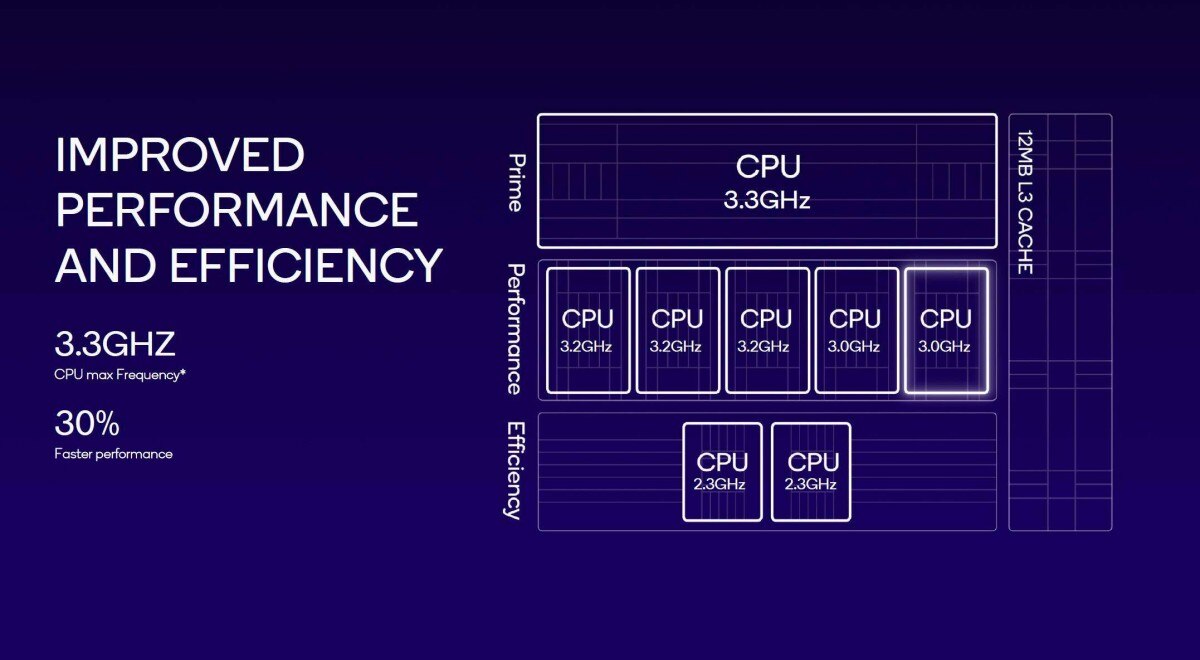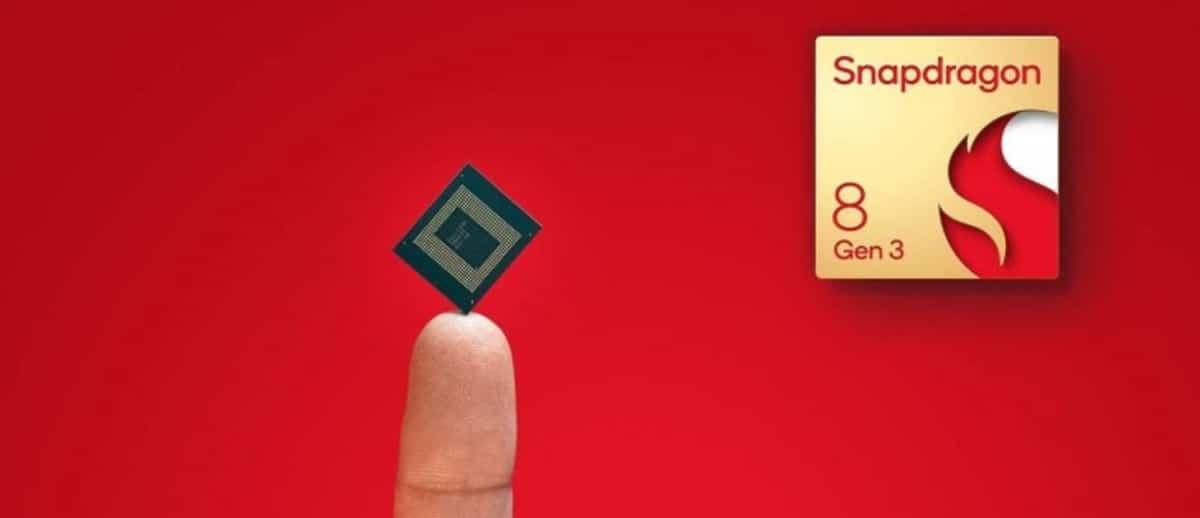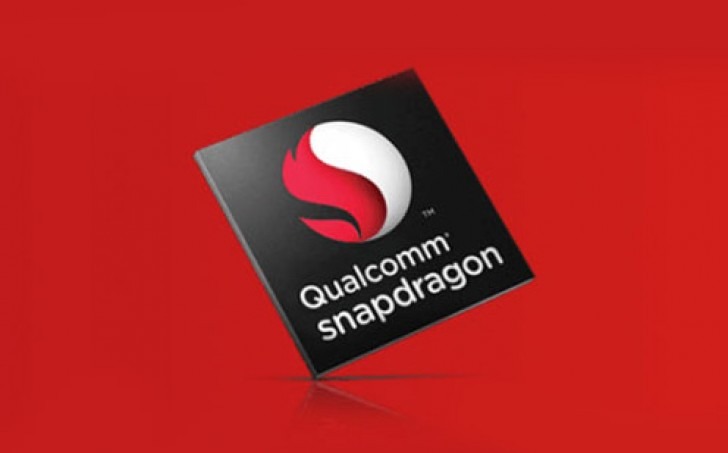Snapdragon 8 Gen 3: phones with Snapdragon 8 Gen 3
Qualcomm has officially released its latest flagship processor. The latest edition focuses on AI, gaming, audio, and camera enhancement. That’s not surprising given that phones with Snapdragon 8 Gen 3 will look to improve on these aspects, and with the new SoC, it will be easily achievable.

The Qualcomm Snapdragon 8 Gen 3 is built on a 4nm process. It’s an Octa-core processor with a 1 Cortex X4 prime core clocked at 3.3GHz. There’s a five-performance core running at 3.2GHz, while the three efficiency cores clocked up at 2.3GHz. And compared to Snapdragon 8 Gen 2, the SD 8 Gen 3 is 30% faster and 20% efficient. The GPU has become 25% faster and 25% power efficient, while Ray Tracing has become 40% better.
Phones with Snapdragon 8 Gen 3 will support LPDDR5x memory up to 4800MHz. There’ll be support for the latest generation of Wi-Fi connection – Wi-Fi 7, up to 6GHz, including 802.11be, 802.11ax, 80211ac, and 80211a/bf/n. Interestingly, there’s a new X75 5G modem with sub-6 GHz and mmWave antennas.
Snapdragon 8 Gen 3 phones will support 4K Ultra HD @ 60 Hz, QHD+ @ 144Hz as maximum on-device display resolution. Externally display resolution can reach 8K @ 30Hz. There will be support for 10-bit color depth, Color Gamut, HDR10, HDR10+, and HDR Vivid.
With the Snapdragon 8 Gen 3, Qualcomm has improved its SoC’s gaming capabilities with ‘console-defying’ gaming with 240 fps support on 240 Hz displays. The Adreno Frame Motion Engine 2.0 can generate frames for smoother playback, and Unreal Engine 5.2 support.
It’s no surprise that Qualcomm has integrated AI into its latest flagship SoC. Qualcomm’s Sensing Hug will securely access personal data like favorite activities, fitness level, and location to give better AI assistance.
Of course, AI will also be used to improve camera performance. Qualcomm’s Semantic Segmentation will enhance vibrancy and image details in real-time, with Night Vision video also getting some improvement. Interestingly, Qualcomm has introduced object erasers for videos to remove unwanted objects or people from your videos. There’s a Vlogger’s View, which can capture both videos from your selfie and rear camera.
Snapdragon 8 Gen 3 phones will support Quick Charge 5 technology, and with Audiophiles, the new SoC will deliver 24-bit 96 KHz lossless music over Bluetooth.
List of phones with Snapdragon 8 Gen 3
Xiaomi 14 series will debut with the SD 8 Gen 3 SoC tomorrow. The Chinese company will release Xiaomi 14 and Xiaomi 14 Pro, which will be the first phones to run the newly released SoC. Asus, Honor, iQOO, Meizu, Nio, Nubia, OnePlus, Oppo, Realme, Redmi, RedMagic, Sony, Vivo, and ZTE are all expected to launch phones with Snapdragon 8 Gen 3 SoC soon.
Updste: November 8, 2023
iQOO 12 series includes two premium devices – iQOO 12 and iQOO 12 Pro. Both features the Snapdragon 8 Gen 3 SoC and comes in the same color options.
iQOO 12 series

IQOO 12 Pro features a 6.78-inch E7 AMOLED panel that refreshes at 144Hz. It supports 144Hz PWM dimming and can reach 3000 nits under the lights. Under the hood, the Snapdragon 8 Gen 3 SoC is paired with a 16GB LDPPR5x RAM and up to 1TB of UFS 4.0 storage. As a gaming phone, there’s a Q1 chip for smooth gaming up to 144Hz for low latency frame insertion, super frame, and supper-resolution
IQOO 12 Pro uses a 5,7055mm² vapor for heat dissipation. Outside of the box, the device runs Origin OS based on Android 14.
The iQOO 12 Pro has impressive camera specs, albeit a gaming phone. It features a primary 50MP 1/1.3″ OmniVision OV50H shooter with OIS. There’s a 64MP 1/2″ telephoto lens, which also supports OIS, and a 50MP Ultra-wide sensor. The selfie camera is a single 16MP f/2.45 shooter.
As expected, the device features a beefy 5,100mAh battery. It supports 120W wired charging and can charge wirelessly at 50W. According to iQOO, the battery will retain 80% of its capacity after 1,600 cycles.
iQOO 12, the vanilla version, shares most specs with the Pro model, but there are few differences. Both phones have a 6.78-inch AMOLED display, but it’s 2800 x 1260px resolution on the base variant, which supports a 144Hz refresh rate.
It has a 4880mAh battery with support for 120W wired charging, and unfortunately, there’s no wireless charging. Meanwhile, there’s a variant with 5000mAh battery.
These phones start at CNY 4,999 (€642) and are available in Black, Red and White. There’s a special BMW M branding edition that comes in White.
Update: October 30, 2023
Xiaomi 14 and Xiaomi 14 Pro are the first phones with Snapdragon 8 Gen 3 processor. The duo features some compelling specs and has ditched the curved edges for a flat metal frame.
Xiaomi 14 Pro

Xiaomi 14 Pro has a 6.73-inch LTPO OLED display. It has a maximum refresh rate of 120Hz while supporting 3000 nits of brightness. Interestingly, Xiaomi Longjing Glass is used instead of Corning Gorilla Glass.
More interesting is the camera. Although Xiaomi ditched the 1-inch sensor on the Xiaomi 13 Pro for a 50MP 1/1.31″ sensor, the latter is about 80% brighter, meaning you get better light-gathering capacity. The primary sensor is accompanied by a 50 MP F/2.0 telephoto sensor with floating Autofocus, and a 50 MP F/2.2 Ultrawide shooter that can shoot 5 CM close objects.
The Snapdragon 8 Gen 3 is paired with up to 16GB of LPDDR5 RAM and 1TB of UFS 4.0 storage. Outside of the box, the device runs Android 14 on top of HyperOS. There’s a 4800mAh battery with support for 120W wired charging and 50W wireless charging.
Xiaomi 14
Xiaomi 14 had the same design as the Pro Model. Both have a symmetrical design with thin bezels and flat frames. However, it features a 6.36-inch LTPO OLED panel with a peak refresh rate of 120Hz while keeping the 3000 nits peak brightness.
The camera looks identical, but there has been minor changes. It’s the same Light Hunter sensor with 1.2um pixels but with a fixed 23mm f/1.6 aperture. Also, the Ultrawide sensor on the vanilla version doesn’t have Autofocus.
The memory configuration is the same, while battery capacity is down to 4610mAh. It supports 90W wired charging and 50W wireless charging.
The duo is available in China starting from CNY 3,999 (€520). They’re available in Black, Silver, Pink, and Green, while there’s a special Titanium hue exclusive for the Xiaomi 14 Pro.
To get our latest news once they’re published, please follow us on Google News, Telegram, Facebook, and Twitter. We cover general tech news and are the first to break the latest MIUI update releases. Also, you get issues-solving “How To” posts from us.



